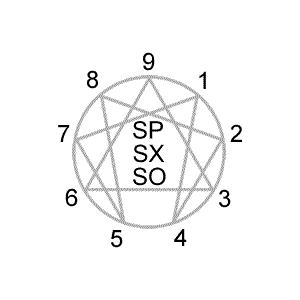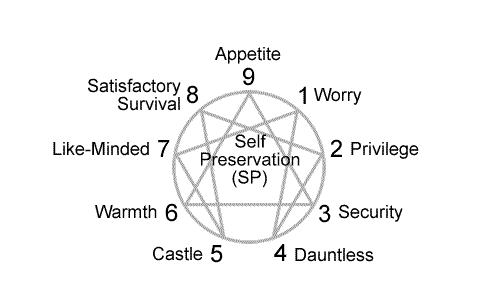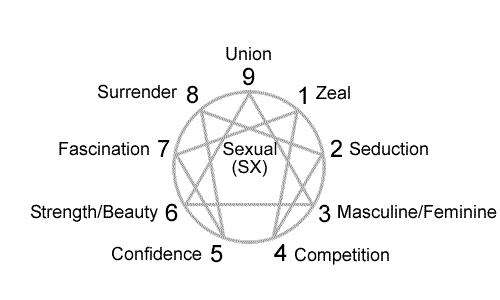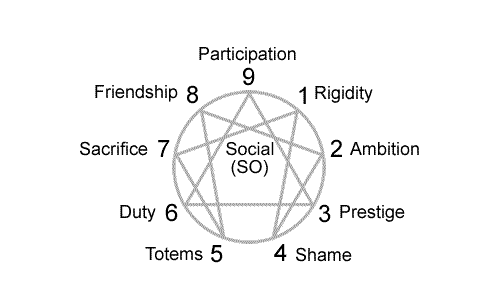Enneagram Subtypes: Type variations based on the instincts

When someone refers to the Enneagram subtypes they're likely referring to the instinctual subtypes. The instinctual subtypes further divide each of the nine personality types into three subtypes: a self-preservation (sp) subtype, sexual (sx) subtype, and social (so) subtype.
With the subtypes you are not simply one of nine types but also one of twenty-seven subtypes. In other words, you are still one of the nine types but you also identify which of the three subtypes for that type fits you best. The subtypes offer one of several explanations as to why two people of the same type might look different (for other explanations visit the type variations page).
Instinctual subtypes are one of two approaches for using the Enneagram instincts. The other approach is instinctual variant stacking.
Below are some common labels used for the subtypes and brief descriptions of each. One of the three subtypes of a type doesn't fit the typical description for that type. This subtype is referred to as the counter-type.
The Self-Preservation (SP) Subtypes

SP 1 - Worry, Anxiety: worries about consequences resulting from things not being done right; avoids mistakes and doing things wrong so as not to be personally blamed or criticized; obsesses about details and likes to be prepared.
SP 2 - Privilege, Me First (counter-type): child-like seduction in order to get for themselves what they need; exaggerated sense of entitlement or privilege; wants to be taken care of but doesn’t want to be dependent.
SP 3 - Security, Company Man/Woman (counter-type): security through hard work, material success, and accomplishments; seeks recognition from others through effort not overt self-promotion; can overidentify with work role and career.
SP 4 - Dauntless, Tenacity (counter-type): stoically endures pain and suffering rather than playing the victim; willingness to jump into new territory in pursuit of personal passion; can be self-punishing, demanding of self in order to forge oneself toward an ideal.
SP 5 - Castle, Castle Defender: hides within “castle walls” to protect against intrusion and maintain privacy; hoards resources and minimizes needs to avoid dependency on others; observes life from a distance instead of participating in it.
SP 6 - Warmth, Affection/Rejection: is warm and friendly as a way to show one is not a threat; cultivates protective and trusting alliances with others; resolves doubt through constant assurance and cautious around potential dangers and risks.
SP 7 - Like-Minded, Family:: networks with like-minded people who support self-interests; on the lookout for opportunities that satisfy their interests and needs; finds good justification for behavior in pursuit of self-interests.
SP 8 - Satisfactory Survival, Satisfaction: takes a direct approach in getting what they want; gets frustrated and intolerant of obstacles that get in the way; accumulates territory and material resources to assure satisfactory survival.
SP 9 - Appetite, Collector: numbs oneself through eating, physical comfort, and routine activities; collects things and may have trouble deciding what to throw away; substitutes essential needs and wants with non-essentials.
The Sexual (SX) Subtypes

SX 1 - Zeal, Jealousy (counter-type): desire to reform people or society to the “right way” to be or do; feels entitled to what’s been “earned” through hard work and high ideals; angry and resentful of those who haven’t earned what they receive.
SX 2 - Seduction, Aggression: seduces or pulls others into close connection and relationship; looks to others to get what they want; aggressive through emotional seduction and manipulation in relationships.
SX 3 - Masculine/Feminine, Charisma: presents attractive and pleasing image to others; promotes and supports important others more so than promoting oneself; success of significant others becomes one’s own success.
SX 4 - Competition, Hate: “more shameless than shameful” in their demand for what they want; competes with others to overcome feelings of internal deficiency; angry envy toward others who have what they don’t or are what they’re not.
SX 5 - Confidence, Confidant (counter-type): searches for someone they can trust to share their secrets with; emotionally sensitive with romantic streak; may connect to inner emotional world through artistic expression.
SX 6 - Strength/Beauty (counter-type): uses strength or beauty to be empowered within the world; stands against fear but more “bark” than “bite”; runs toward fear or danger with attitude of the best defense is a good offense.
SX 7 - Fascination, Suggestibility: lured or pulled by imaginings or fantasies that embellish reality; an optimism of someone who’s in love; can be easily overtaken by enthusiasm and fascination for an ideal.
SX 8 - Surrender, Possession: rebelliously asserts their “truth” or “way” in place of the rules or norms; wants others to surrender control, wants to dominate others and surroundings; can have difficulty letting go of what’s been “possessed” or taken under their control.
SX 9 - Union, Fusion: sense of being comes from merging with significant others; can have difficulty individuating and standing on their own without reference to other; tendency to lose sight of own needs and desires in favor of other.
The Social (SO) Subtypes

SO 1 - Rigidity, Non-Adaptable: already knows the “right way” so no need to adapt to what others say is “right”; provides example by modeling how one should be; sense of superiority can come from criticality of others for not behaving the right way.
SO 2 - Ambition: wants to lead, stand out, have influence and advantages; promotes themselves through association with people of status and influence; generosity is used strategically to influence and gain advantage.
SO 3 - Prestige, Achievement: adopts the persona and image that garners respect, approval, admiration, etc.; can confuse persona and image with who they truly are; enjoys the spotlight and achieving success, reputation, status, influence as they climb the social ladder.
SO 4 - Shame, Honor: attracts support by expressing their suffering to others, takes on the victim role; self-defeating focus on sense of inferiority when comparing self to others; feels guilty for wishing, desiring, shameful feelings about self in comparison to others.
SO 5 - Totems, Symbols: relates to people through ideas, values, and ideals; searches for ultimate knowledge, truth, and meaning to avoid experiencing life as meaningless; obsession with ideas and the extraordinary which disconnects them from everyday issues and concerns.
SO 6 - Duty, Fellowship: knows and follows the rules to relieve anxiety; relies on ideologies or other systems of reference; can be precise, intolerant, and adhere to guidelines of authority to avoid ambiguity.
SO 7 - Sacrifice (counter-type): postpones or defers desires and gratification in favor of pursuing an ideal; moved by duty and recognition toward service of humanity; seeks recognition and applause for being good according to social consensus.
SO 8 - Friendship, Solidarity (counter-type): seeks advantage and influence through associations and alliances; defends those under their protection from injustice, unfairness, and harm; appears more friendly, generous, and less aggressive than other type 8 subtypes.
SO 9 - Participation (counter-type): participates in order to feel a part of the group; prioritizes group needs above their own and works hard toward those needs; fun-loving, sociable, congenial, doesn’t weigh others down with own woes.
How to determine your subtype?
Typically the way to find your subtype is to first find your Enneagram type then look at the three subtypes for that type.
If you already know your Enneagram type then you can take the subtype comparison test on this website to see how the three subtypes rank for you.
If you don't already know your Enneagram type then find your type first and take the subtype comparison test afterward.
Click here for the Complete Guide to the Enneagram.
This free guide explains- the nine Enneagram personality types
- the many type variations within type
- where the types came from (origins and history)
- how the types use the Enneagram symbol
Click here for Enneagram tests.
These free tests help you find your- primary type
- candidate types
- preferred wing
- intinctual subtype
- instinctual variant stacking
- center types (gut, heart, and head)
- tri-center with wings